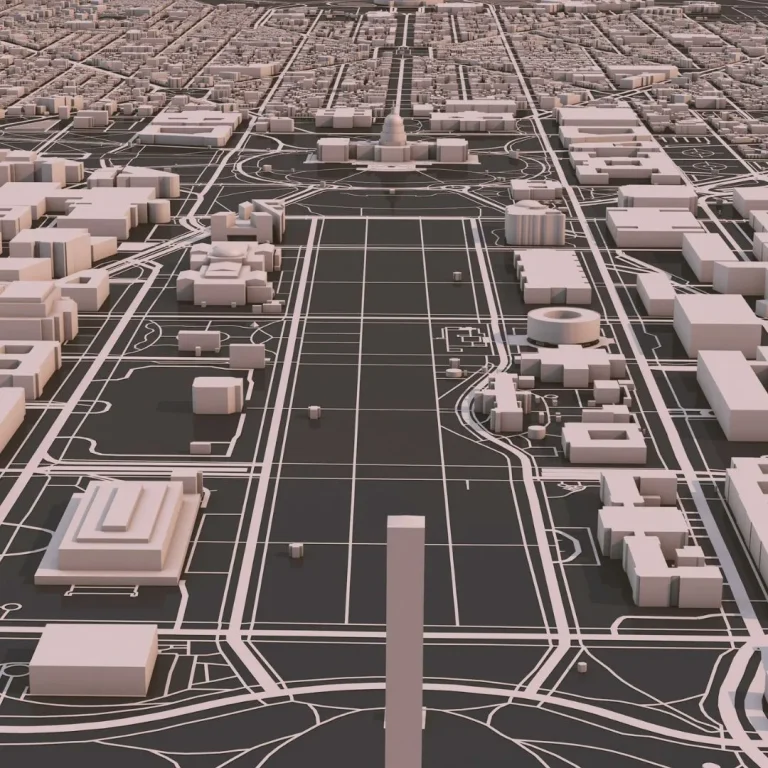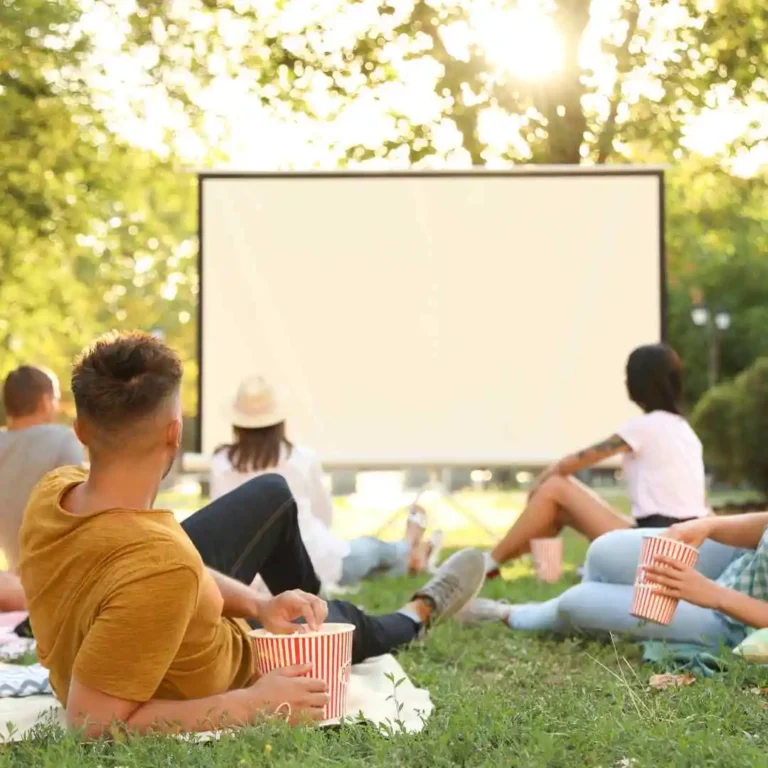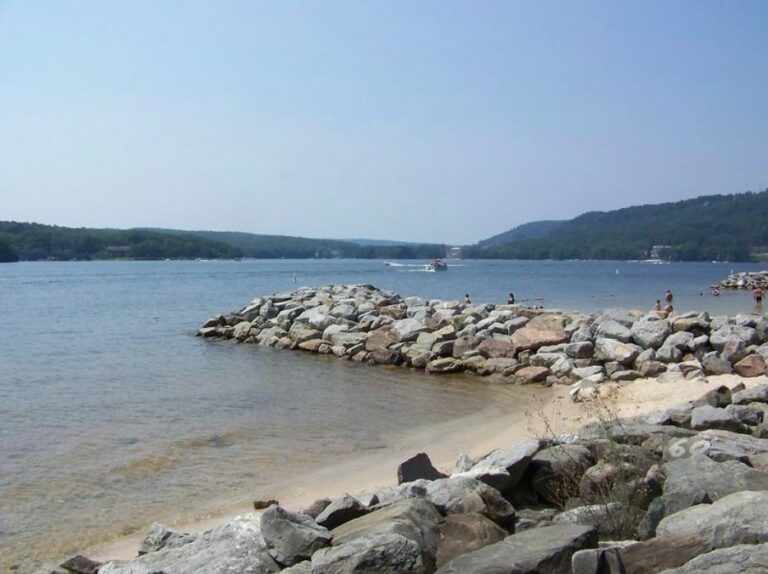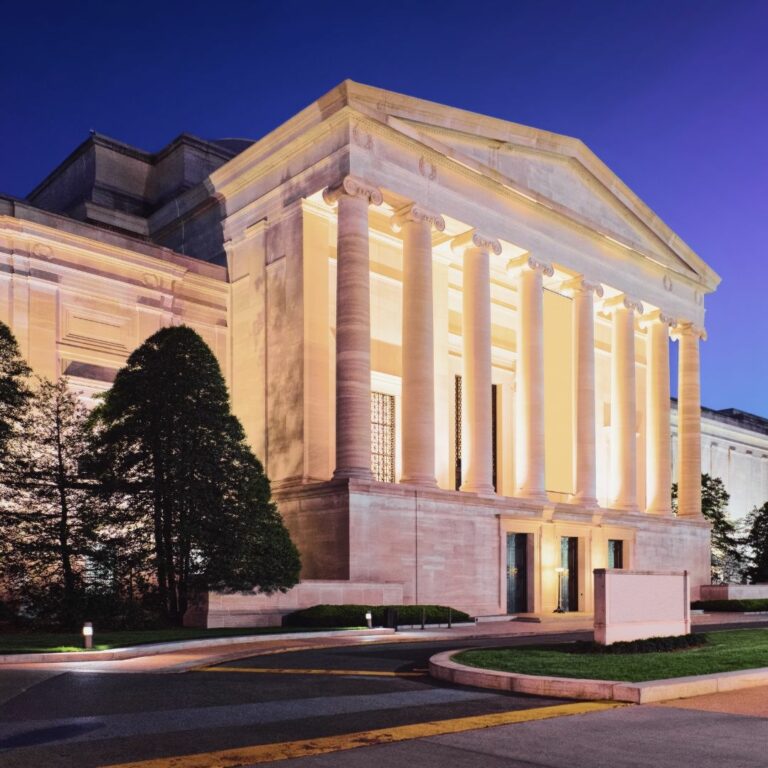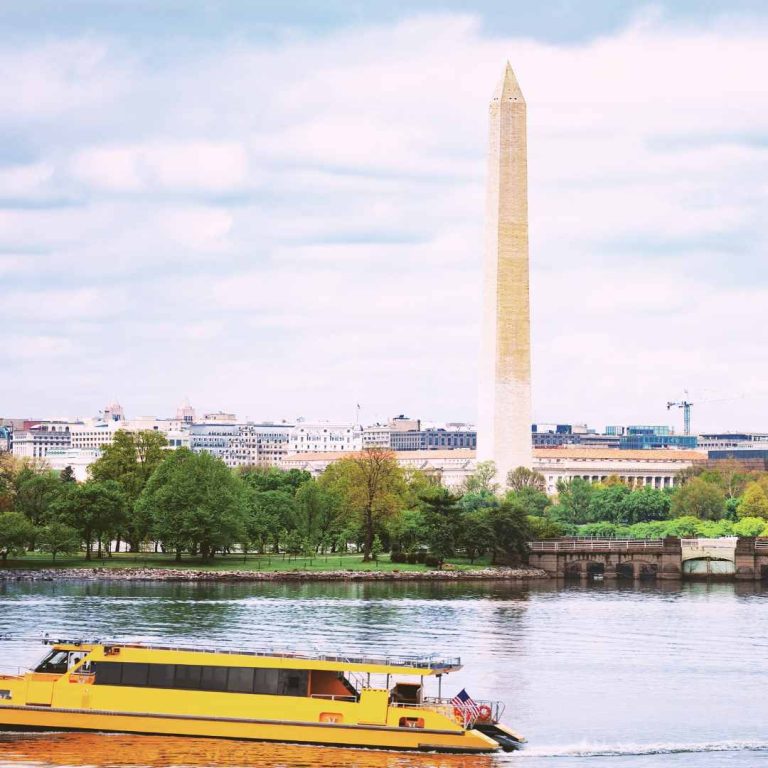Georgetown is one of Washington DC’s oldest neighborhoods. It is a charming mix of history, culture, and leisure activities for all ages to enjoy. Let’s take a look at the best things to do in Georgetown DC.
Things To Do In Georgetown DC: Sightseeing
Cultural enthusiasts will appreciate the many attractions that have historical significance in this part of Washington DC. Let’s take a look at the best places with historic beauty in Georgetown.
Dumbarton Oaks House And Garden
Dumbarton Oaks Museum & Garden is a historic estate and garden located in Georgetown Washington, D.C. The property has beautifully designed gardens and significant collection of art and artifacts.
The estate originally dates back to the late 17th century. Robert Woods Bliss and Mildred Barnes Bliss purchased the property in the early 20th century. Over the years, they transformed it into a place of culture, art, and beautifully landscaped gardens.
The gardens at Dumbarton Oaks were primarily designed by the famous landscape gardener Beatrix Farrand in collaboration with Mildred Bliss. The garden is structured as a series of terraced rooms and outdoor “garden rooms,” each with its own character and specific plants. Dumbarton Oaks garden has ornamental fountains, terraces, winding pathways, and a variety of plantings that offer beauty in every season.
In addition to the gardens, Dumbarton Oaks also houses an important research library and a collection of Byzantine and Pre-Columbian art, as well as European artworks and furnishings. The institution is a center for scholarship in Byzantine, Pre-Columbian, and Garden and Landscape studies. Scholars from around the world come here to conduct research. Right next to the formal gardens is the 27-acre Dumbarton Oaks Park.
You can check the Dumbarton Oaks website for more information on visiting. The entrance is about a 15 minute walk from M street in Georgetown.
C&O Canal
The C&O Canal stands for the “Chesapeake and Ohio Canal.” C&O Canal Tours leave from the Georgetown Visitors Center, which is just off of M Street. This canal is famous for many reasons.
The C&O Canal was constructed in the 19th century as a transportation route for goods, primarily coal, from the Allegheny Mountains to port cities. The canal operated from the late 1820s until 1924.
Given the technologies of the time, the canal was an impressive engineering accomplishment. It stretches over a hundred miles from Georgetown in Washington, D.C., to Cumberland, Maryland. Along its length, there are multiple lock lifts, aqueducts, tunnels, and other structures that allowed boats to navigate the changing elevations and terrain.
Commercial use of the canal declined in the 20th centure. After this decline, the canal was preserved as a National Historical Park, managed by the National Park Service. Today, the canal’s towpath offers a serene setting for walking, jogging, cycling, and bird-watching.
Site Of Key Mansion
Key Mansion is also called the Francis Scott Key House, and sometimes known as the Francis Scott Key Mansion. Francis Scott Key was the author of “The Star-Spangled Banner” (which later became the national anthem of the United States), use to live here.
During discussions with representatives from the National Park Service, a journalist discovered that Francis Scott Key’s home was once located near the Key Bridge on M Street in Georgetown, was demolished in 1947. Parts of the house were preserved for potential future restoration. Yet, by 1981, the Park Service appeared to have lost track of these materials.
So the house no longer exists, but you can visit the site at 34th and M.
Georgetown University
Georgetown University was founded in 1789. It is the oldest Catholic and Jesuit institution of higher education in the United States. The iconic Healy Hall is known for its stunning Gothic architecture.
In recent years, Georgetown’s own history with slavery has come to the forefront. In the 19th century, the university benefited from the sale of enslaved individuals to ensure its financial stability. In 1838, two Jesuit priests who were presidents of Georgetown arranged the sale of 272 enslaved African Americans owned by the Maryland Jesuits. This sale was used to pay off debts and keep the university financially viable.
Recognizing this dark chapter, Georgetown has taken steps to acknowledge and atone for its past. This has included offering admissions preference to descendants of those enslaved individuals and renaming buildings. This initiative has sparked nationwide conversations about the role of universities in addressing historical injustices
Mt. Zion Historic Cemetery
Mount Zion Cemetery also called Methodist Episcopal Burying Grounds; Female Union Band Society Graveyard is an important historical site in Georgetown. This cemetery is one of the few remaining physical reminders of the significant contributions of Black people to the development of Georgetown. The cemetery is located at 27th Street NW and Q Street NW in Georgetown.
The site is actually a combination of two cemeteries. The Mount Zion section was controlled by the Mount Zion United Methodist Church, while the adjacent Female Union Band Society section was owned and managed by a cooperative benevolent association of free Black women.
The cemetery stands as a testament to Georgetown’s early African American community. Here you can see insights into their lives, struggles, and societal roles, especially during the eras of slavery. It is the final resting place for several notable African Americans from the era, including shopkeepers, artisans, war veterans, and members of prominent families.
Exorcist Stairs
This is one of the most popular attractions in Georgetown especially for movie buffs. In the movie “The Exorcist,” the stairs are the site of a memorable scene where the character Father Damien Karras meets a tragic fate after confronting the demon possessing the young girl, Regan.
The steps are located at the corner of Prospect Street and 36th Street NW in Georgetown. The stone stairs are ver steep and very narrow which adds to the scene’s dramatic and terrifying impact.
Due to the film’s immense popularity and the stairs’ role in one of its most shocking scenes, the steps have become a tourist attraction and are considered a cultural landmark in D.C. Visitors and fans of the movie often make their way to the stairs to see them in person, sometimes reenacting scenes or simply capturing photos. In 2015, the Exorcist Stairs were officially recognized as a D.C. historic landmark, and a commemorative plaque was installed at the site.
Old Stone House
The Old Stone House is one of the oldest standing buildings in Washington D.C. It was built in 1765 and it is actually the oldest unchanged building in Washington DC.
The house was originally a residence. Then, later it also served various commercial purposes, including being a used as a shop and a car dealership in different eras. Its continuous use over the centuries offers a window into the evolution of life and commerce in Georgetown.
The house is located on M Street in Georgetown, a bustling area known for shopping and dining. Its presence amidst the modern urban setting of present day Georgetown serves as a tangible link to the past. The Old Stone House is open to the public for guided tours, and there is no admission fee.
Tudor Place
Adding to the historic charm of Georgetown is Tudor Place Historic House, a neoclassical mansion built in the early 1800s. Spanning over five acres of land, Tudor Place not only boasts a captivating architectural style but also houses a wide collection of historical artifacts, including items that belonged to George and Martha Washington.
Oak Hill Cemetery
Oak Hill Cemetery in Georgetown is a historic burial ground that was established in 1848 by the banker and philanthropist William Wilson Corcoran. The cemetery’s design reflects the “garden cemetery” movement of the mid-19th century, which emphasized natural beauty, picturesque landscapes, and winding paths.
Oak Hill Cemetery is the final resting place for many prominent individuals, including Dean Acheson who was the U.S. Secretary of State under President Harry S. Truman. Ben Bradlee who was the executive editor of The Washington Post during the Watergate scandal is also buried here. Many others have their resting place here including senators, congressmen, diplomats, Civil War veterans, artists, and authors.
The cemetery’s rolling hills, mature trees, and scenic vistas overlooking Rock Creek Park offer a peaceful and contemplative environment. Its landscaping and design make it not only a place of rest but also an attractive spot for those interested in history, architecture, and nature.
Things To Do In Georgetown DC: Dining & Drinking
Georgetown has some of the best restaurants and bars in Washington DC. From outdoor eateries to rooftop bars, there are so many tasty places for your palate to experience.
Cafe Milano
Perhaps one of the most well known and iconic restaurants in Georgetown is Cafe Milano. Aside from the tasty food, this restaurant has been known to host power lunches and power dinners with some of DC’s most significant individuals. The restaurant is one of many great Italian restaurants in this neighborhood. A full list of the best Italian restaurants in Georgetown can be found here.
Rooftop At The Rosewood Hotel
The Rosewood Hotel is a luxury hotel just off of M street in Georgetown. The stunning rooftop is a great place to unwind, have a drink, and take in the views. In addition to drinks this rooftop also has a small menu of food that you can enjoy as well. If traveling with a group, the Rosewood is one of many luxury hotels in DC that are great for families.
Rooftop At The Graham Hotel
This is another very popular rooftop bar in Georgetown. It is one of the favorite places amongst locals as well as visitors. You can make a reservation online to enjoy a drink or a glass of wine here. It the weather is not fit for a rooftop evening, the hotel also has a speakeasy bar downstairs. This hotel is located just off of M street making it very convenient to get to.
Coffee Shops
Georgetown is also famous for having several cute coffee shops. Almost on every corner and even in between you can find a coffee or tea shop where you can enjoy a variety of different drinks. Some of the popular coffee shops in Georgetown Washington DC are Baked and Wired, Blue Bottle Coffee.
Specialty Dessert
Georgetown also has a number of small shops where you can get yummy desserts and sweets. Some of the popular places are Thomas Sweets (on Wisconsin), Laduree, and Georgetown Cupcake. You can easily walk to one of these after you have a meal or to enjoy with a cup of coffee.
Things To Do In Georgetown DC: Shopping & Strolling
The Georgetown neighborhood has beautiful cobblestone streets, upscale shops, fine dining, and waterfront views. From the scenic Potomac River waterfront to exquisite historic homes and gardens, Georgetown is a great place to just walk around and take in the ambiance. Here are some of the fun areas to shop and stroll in Georgetown Washington DC.
M Street
M Street in Georgetown is one of Washington, D.C.’s best shopping destinations. M street is the heart of Georgetown. This main drag of the Georgetown area is lined with a variety of stores ranging from high-end designer boutiques to popular national retail chains.
From large clothing stores like Aritizia to smaller boutiques, there’s plenty of stores here for both men and women. If you are interested in buying home goods or furniture there are several stores here for that as well.
You will need a bite to eat in between all your shopping. M Street and its surrounding area have numerous restaurants, cafes, and eateries, offering everything from quick bites to gourmet meals. This makes it convenient to take shopping breaks and enjoy some of D.C.’s best food offerings.
Georgetown Waterfront
Not far from M Street is the Georgetown Waterfront. This part of Georgetown is located on the banks of the Potomac River. There are many free things to do here.
The Georgetown Waterfront Park is a beautifully landscaped space where visitors can relax, have picnics, or simply enjoy the views of the river and the Kennedy Center. The park features fountains, benches, and pathways.
There are numerous restaurants and cafes along the waterfront, many with outdoor seating that provides direct views of the Potomac. Fiola Mare is particularly famous for its excellent cuisine, upscale dining, and waterfront location.
For those who want to be more active, there is a lot you can do here as well. Outdoor enthusiasts can also rent a kayak, canoe, or paddleboard from places like the Key Bridge Boathouse and paddle on the Potomac River. The Capital Crescent Trail, a popular mixed-use trail, runs through the area, making it a great spot for cycling, jogging, or walking.
The waterfront offers picturesque views of the Potomac, Roosevelt Island, and the Key Bridge. It’s a popular spot for photography. If you want to explore by water, there are several companies that offer boat cruises from the Georgetown Waterfront. This is a nice and relaxing way to take in the beautiful views of Washington DC.
Key Bridge Boathouse
The Key Bridge Boathouse is located at the foot of the Francis Scott Key Bridge, which connects Georgetown in D.C. to Arlington, Virginia. One of the main attractions of the Key Bridge Boathouse is the opportunity to rent kayaks, canoes, and stand-up paddleboards.
The Potomac River provides a picturesque environment for paddling especially in the fall and summer months. You can enjoy views of the D.C. skyline, the Key Bridge, and the natural beauty of the river itself.
The boathouse offers lessons for beginners and guided paddling tours. These tours can include moonlight paddling excursions and other themed outings.
Wisconsin Avenue
Running slightly perpendicular to M Street is Wisconsin Avenue. This is another popular part of Georgetown. There are many small stores here as well restaurants. Some popular restaurants on Wisconsin include Lutece as well as Thomas Sweets.
This is a bit quieter than M street but it is still quite busy. You will find many great restaurants to check out as there are also several coffee shops here.
Cady’s Alley
Cady’s Alley is also an offshoot off of M street. But if you don’t look out for it, you could miss it. This alley is a hidden gem that artfully blends historic architecture with modern retail and design.
Cady’s Alley is a pedestrian-only, brick-lined lane hosts several high-end boutiques, cozy cafes, and contemporary art galleries, making it an ideal destination for shopping and leisurely stops.
Things To Do In Georgetown DC: Music
Georgetown, Washington D.C. is home to a diverse range of music and entertainment venues that cater to various tastes and preferences. From intimate jazz clubs to world-class performance spaces, people visiting the area can immerse themselves in a rich cultural experience.
Blues Alley
Blues Alley is located in the heart of Georgetown. It is a legendary music venue that has been hosting live jazz and blues acts since 1965. As the oldest continuously operating jazz supper club in the United States, it has an intimate vibe for music lovers. The candlelit tables, brick walls, and top-quality acoustics create a memorable ambiance for everyone.
Blues Alley has been in operation since the mid-1960s and has gained a reputation as one of the premier jazz venues in the country. Over the years, many renowned jazz musicians have graced the stage at Blues Alley, including Dizzy Gillespie, Sarah Vaughan, Nancy Wilson, Grover Washington Jr., and many others.
In addition to offering a top-notch musical experience, Blues Alley also has a full-service dining menu, allowing patrons to enjoy a meal with their music. Located in an alley off the historic streets of Georgetown, Blues Alley’s location adds to its charm. The brick facades and cobblestone streets of Georgetown provide a picturesque backdrop for a night of jazz.
Bistrot Lepic & Wine Bar
Bistrot Lepic is not only a French restaurant but also a cozy space that features live jazz music upstairs. With a good wine list and delightful menu, it’s a perfect spot to unwind and enjoy some great tunes while savoring delicious dishes.
Kennedy Center
The Kennedy Center is not technically in Georgetown, but it is very close by. As the national center for performing arts in the U.S., it hosts a wide variety of events, including music, theater, and dance performances.
While the Kennedy Center hosts many ticketed events, including performances by the National Symphony Orchestra, the Washington National Opera, and various touring artists and productions, it also offers a variety of free events. One of the most notable free offerings is the Millennium Stage, which provides free performances every day at 6:00 pm. Seating is on a first-come, first-served basis.
The Kennedy Center occasionally hosts special events, festivals, or exhibitions that might have free components. Music lovers will undoubtedly find a show or concert to suit their tastes, making it a must-visit location for anyone seeking a memorable night out.
Things To Do In Georgetown DC: Summary
Georgetown is the oldest neighborhood in the nation’s capital. From historic places to great restaurants, its easy to spend one to two days exploring this part of Washington DC.
While Georgetown does not have any Smithsonian Museums, the historic neighborhood of Georgetown has many things to do. Enjoy walking the picteresque streets, learning about the rich history, and exploring the C&O canal. On M street NW you can also shop at one of the many stores here, from chain stores to boutiques there’s a lot of options for shopping. End your evening by dining at one of Georgetown’s many restaurants or grabbing a drink at one of the swanky bars here.


